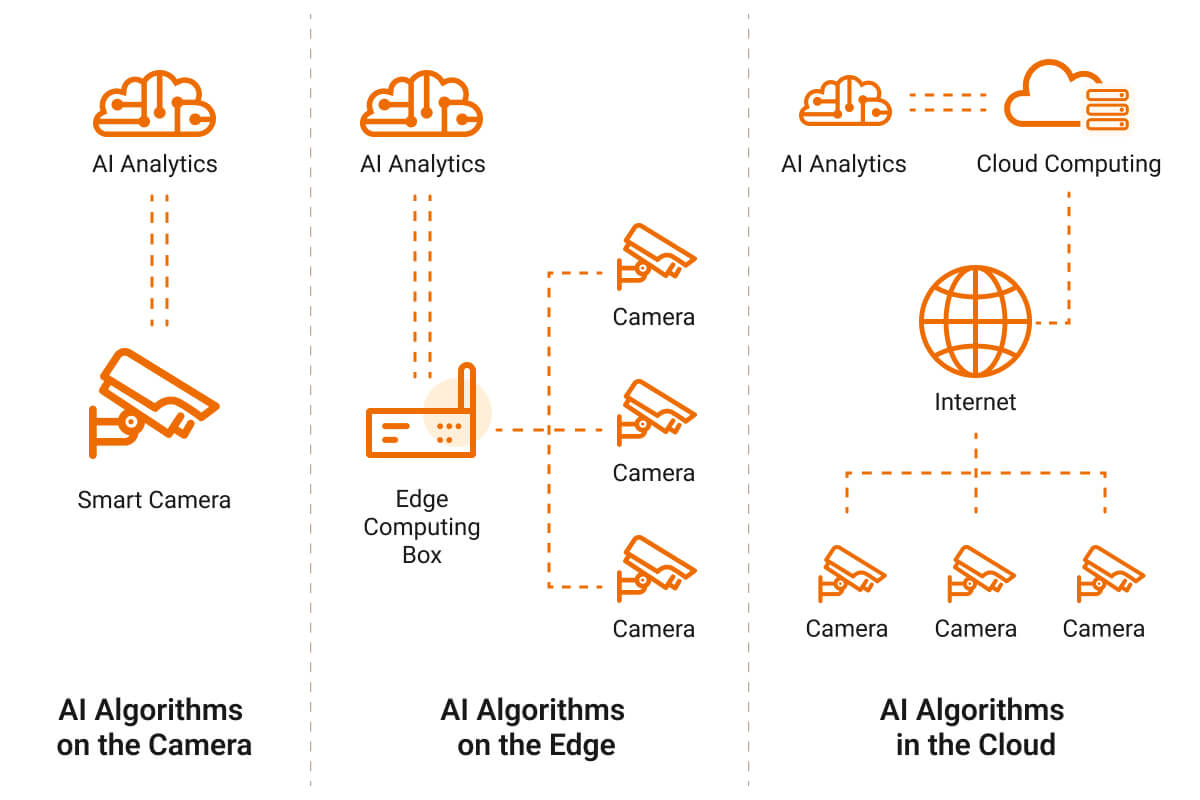ThingsBoard is transforming and making data collection, processing, and visualization easy with any IoT devices. The platform has established vast relationships with significant companies and individuals who have links of their devices to the Thingsboard server and network.
Dusun IoT is also one of the Thingsboard gateway hardware partner.
The majority (60–80%) of Internet of Things (IoT) devices are dumb terminal devices (don’t support IP), hence the ThingsBoard IoT gateway is crucial since it allows non-IP devices to connect to the cloud platform. Currently, the platform is also expanding by introducing new ways to use it for environmental monitoring, smart retail, home health monitoring, smart farming, and home energy management, among other productive activities.
What is Thingsboard?
Thingsboard is a reliable open-source platform for data collection, device management, and visualization. The platform offers Rest API, a user interface that supports various entities that work together to achieve a particular goal of providing and managing multiple entity kinds and their relationships in your IoT application.
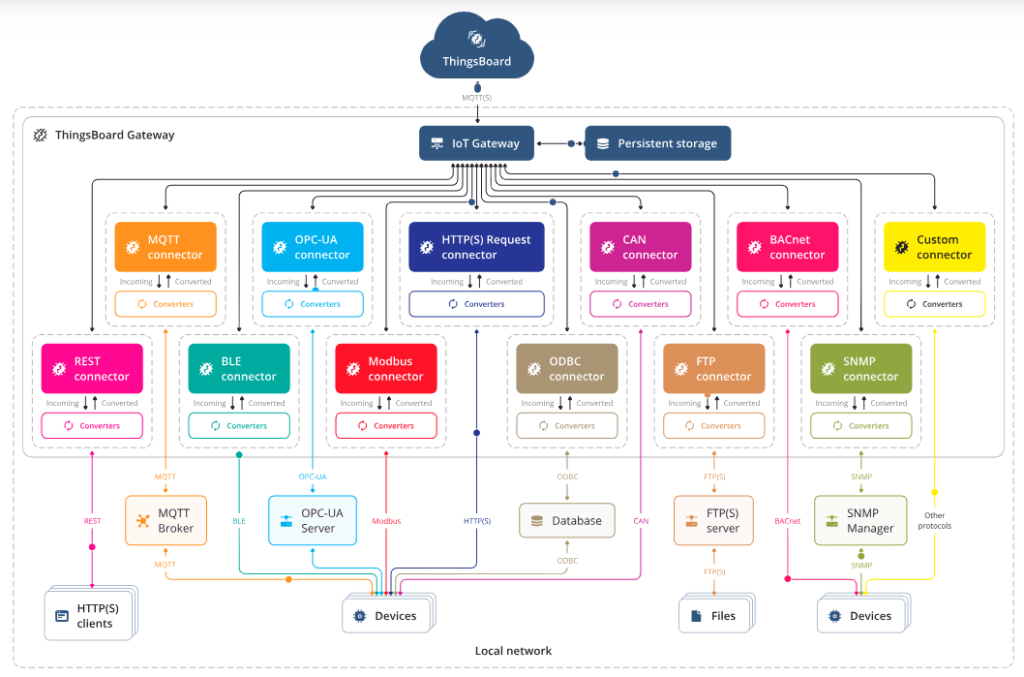
source: thingsboard.io
An example of entities is the tenants representing a person or a company that owns or produces property. In this platform, you can regard a tenant as a distinct business entity with many clients, devices, and assets. When it comes to users, they have the opportunity to access the dashboard and the ability to manage entities.
How Does Thingsboard Works
Thingsboard works by string entities, which represent devices, assets, customers, and dashboards in the database, and currently supports three different types of databases. SQL is the language implemented to store all entities and telemetry data and its primary goal is the Postgres SQL and to ensure the designers of Thingsboard advocate how to use it.
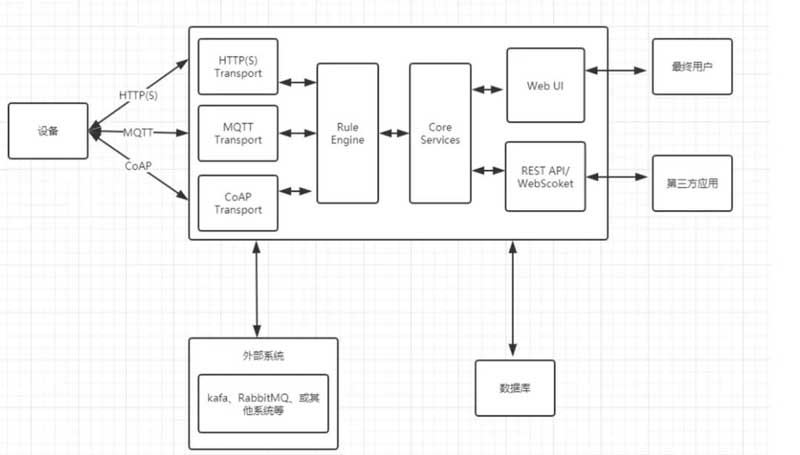
However, we do not advise individuals to use the hybrid database except for test execution and launching development instances with the least load.
The other type of database that the platform uses is the NoSQL which stores all the telemetry data and entities. Currently, thing broad only supports Cassandra as NoSQL, so we advise you to try implementing it. Please note that due to the NoSQL limits for transactions and “joins” that are necessary to provide comprehensive research on IoT items, the option of using NoSQL has been superseded in favor of the hybrid approach.
ThingsBoard Features
ThingsBoard Rule Engine for IoT and Fault Tolerance
The platform’s brain is the ThingsBoard rule engine, which is in charge of handling incoming messages. Nodes from the rule engine can form a cluster in which each node is in charge of a certain division of the new messages. Additionally, the rule engine is subscribed to incoming data feeds from queues. The shared and isolated modes of the Thingsboard rule engines are available, and the rule engine in shared mode processes messages from various tenants.
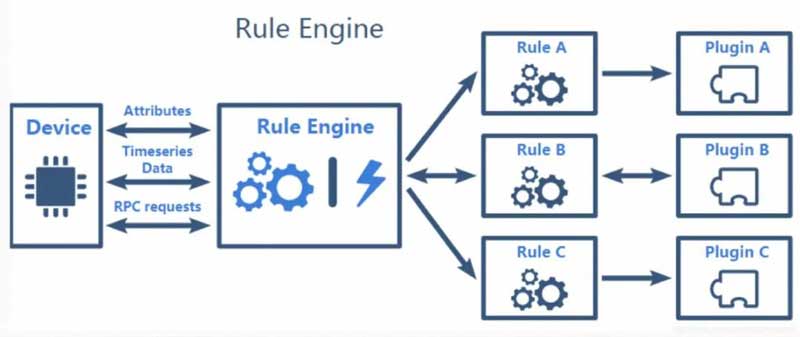
When it comes to isolated mode, the rule engine can be set up in isolated mode to only process messages for each certain tenant. Regarding fault tolerance, all the platform servers are the same, and no hot stand or master employees are needed to execute certain functions.
Additionally, if the node fails, it is automatically discovered, and no downtime is necessary when replacing failed nodes. Additionally, eligible NoSQL databases are used to replicate persisted data.
Device Managment and Security
The device manager allows for the management and registration of devices, which permits both servers- and client-side device attribute provisioning and monitoring. The administration also provides an API that enables server-side programs to instruct devices via RPC and the other way around.
When it comes to security, applications that are operating on the device require device credentials to interact with the Thingsboard server. Different device credentials are supported by the design of the Thingsboard, and currently, the platform only supports three various forms of databases. Additionally, access tokens are all-purpose credentials that work with multiple gadgets. It is possible to employ DLTs access token mode or one-way SSL mode with access token-based authentication.
ThingsBoard Alarms IoT System
With Thingsboard, you can generate and manage alarms for your entities, such as customers and devices. For instance, you may set Thingsboard up to automatically generate an alarm whenever the thermal sensor reading exceeds a predetermined level. Typically, this is a fairly simplistic example, and real-world situations can often be far from intricate.
Additionally, Thingsboard distinguishes between alarms based on the origin, start time, and type. As a result, only one live alert has the same originator, kind, and start time at any one time. Assume for the moment that you have set up alarm rules to generate a “high temperature” alarm whenever the temperature exceeds 20. Additionally, you included alarm rules that will turn off the alarm whenever the temperature is at or below 20 degrees.
The alarm will always alert you under these circumstances and notify you of any changes concerning temperature. Consider a topology where each client has 1000 devices in a customer setting, and one tent has about 1,000 clients. As a result, your server application installations contain 1 million widgets.
Thingsboard is designing a dashboard that shows all active alarms at the tenant and client level, which is a good idea since the platform allows the dissemination of the alert to reduce the complexity of SQL statements and speed up load times. Therefore, we can indicate whether or not the alarm should be visible to parent entities when it is generated and specify the relations, which is optional.
The Advantages of Using Thingsboard
High Connection, Scalability, and Availability
Thingsboard provides higher deployments on bare–metal or K8S in both on-premises information centers and the cloud. You can scale platform elements horizontally since the platform’s production deployment supports more than 500,000 linked devices. When it comes to connectivity, using the platform’s built-in protocols, you may connect devices directly to it using MQTT, SNMO, and HTTP, among other options. Utilizing a broad gateway creates various opportunities, such as using BLE, OPC-UA, and Modbus to connect local network devices to the cloud.
Effective Data Processing and Visualization
The platform uses a rule engine, a reliable and scalable processing system that relies on commercially available message queue implementations, such as Apache Kafka, to guarantee data processing and data durability. The rule engine is conveniently open for use in data processing or sending data to the external system for additional processing.
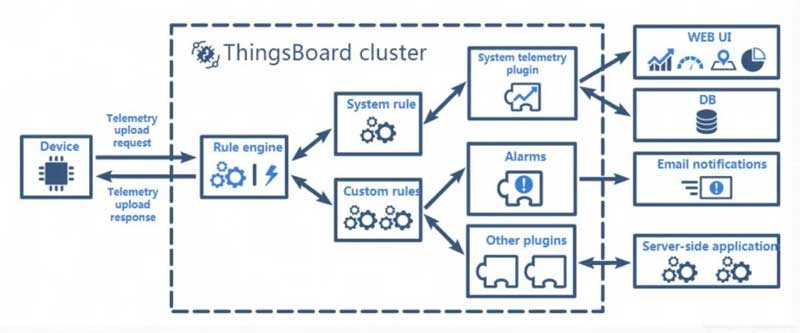
When it comes to visualization, the interactive dashboards of the Thingsboard contain visualized gathered data. The dashboards have interactive features such as control widgets, maps, and built-in charts with no coding required. You can utilize the complex widget option or bespoke bundles to customize every dashboard aspect. Additionally, low bandwidth updates are possible with embedded web socket capability.
Mobile Application
With the Thingsboard application on a mobile, you can build an interactive project on flutter to quickly and easily create your IoT mobile application. Additionally, you can utilize a series of mobile actions already incorporated into the dashboard to take a picture, scan a QR code, change your position, and do other activities. To manage tenants, clients, users, devices, and assets, Thingsboard offers a user interface and API. With the platform, an individual tenant may have millions of clients, devices, and tenant administrators.
Thingsboard Use Examples
Monitoring Smart Energy and Analyzing Its Efficiency
The ThingsBoard platform ensures that it has reduced all the time and effort to develop smart energy solutions which are significantly reduced. If you explore its features and other techniques effectively, you can reduce the production time of your smart energy solution by up to 90%. What makes Thingsboard unique is how dependable and expandable it is in terms of how you can gather data.
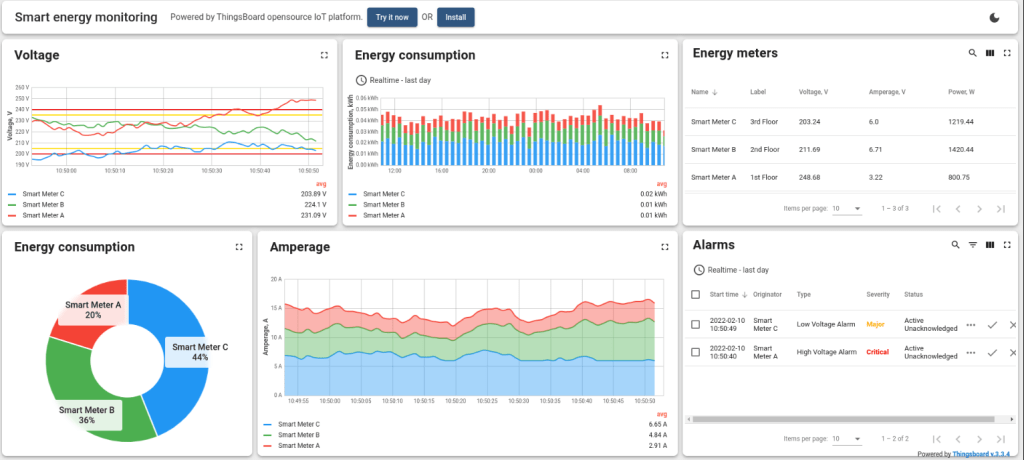
Additionally, its robustness is capable of processing any data collected, generating alarms, and producing insightful information. Regarding data visualization, the platform contains an advanced and adaptable visualization of current and past data. Therefore, you can store and preview any data in the future.
You may also be interested in IoT energy management using smart meters
We cannot talk about monitoring smart energy without mentioning the Thingsboard dashboard because ThingsBoard create dashboard to assess and disseminate the findings of entry analysis and monitoring. Additionally, the dashboard will use MQTT API to collect real-time data from many smart meters and display it in the live dashboard. The rule engine will then process the collected data to trigger alarms when specified thresholds are reached.
Smart Farming Solutions
The creation of smart farming solutions requires significantly less time to market, thanks to the Thingsboard platform. You can employ several features such as the robust rule engine, the customizable dashboard, and a flexible data visualization to keep records of your data that are advantageous and will ensure that the smart farming solution is designed and developed on time.
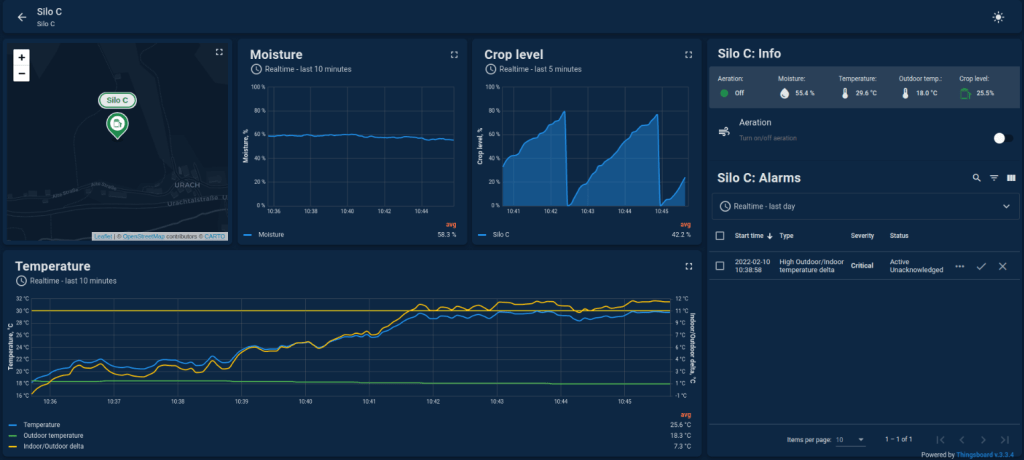
source: thingsboard.io
For smart farming to be effective, the platform collaborates with other companies such as Dusun that provide dependable and fault-tolerant data-collecting devices that enable you to track the condition of your facilities and other variables like crop growth traits, germination rate, and humidity levels. Additionally, the automatic remote actuator enables you to reduce resource use, thereby saving you money.
You may also want to know IoT Agriculture System Based on LoRaWAN
Regarding data visualization, the platform consists of an advanced and adaptable visualization to help store data for future access and use. The platform also offers server infrastructure prepared for production links to your IoT devices and ready you to access the interactive dashboards and other features to create smart farming solutions.
Environmental Monitoring
The platform plays a crucial function in the Environmental department by performing functions such as monitoring the air quality in major towns and cities and even the average weather in an entire continent, including Antarctica, relief monitoring, checking the quality of water, and seismology alerts or predictions. Therefore, if you fully exploit the platform, the harmonious working of its interactive features will reduce your Environmental monitoring project by up to 90%.
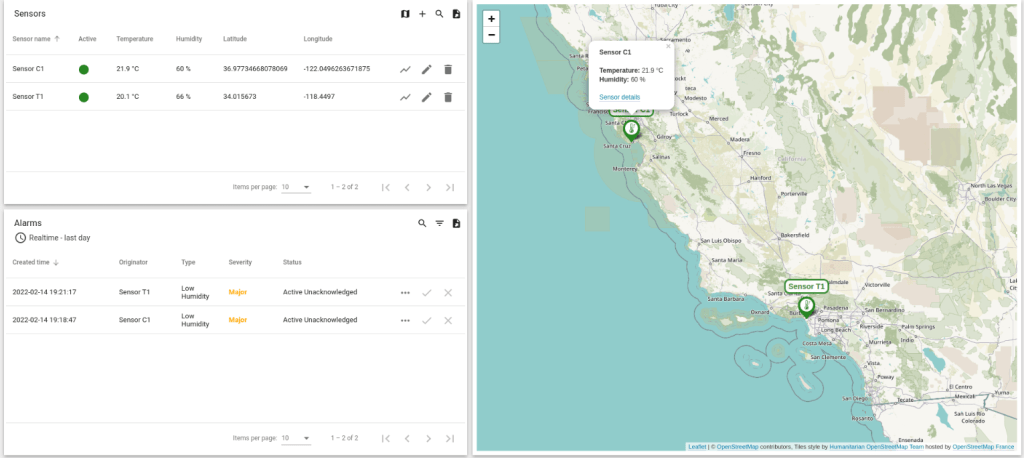
The dashboard, a component of the solution template, displays the results of temperature and humidity sensors that have been gathered in real time using MQTT API. The dashboard allows you to customize it, where you can choose to alter the placement of the sensor and establish the alarm thresholds.
You may also want to know: IoT remote monitoring
Wrapping it Up
Thingsboard provides an intelligent way to collect, monitor, visualize and process data from different areas using technology. The platform is interactive and allows individuals and other companies to connect their IoT devices and use its unique features, such as the interactive and customizable dashboard and a robust rule engine.
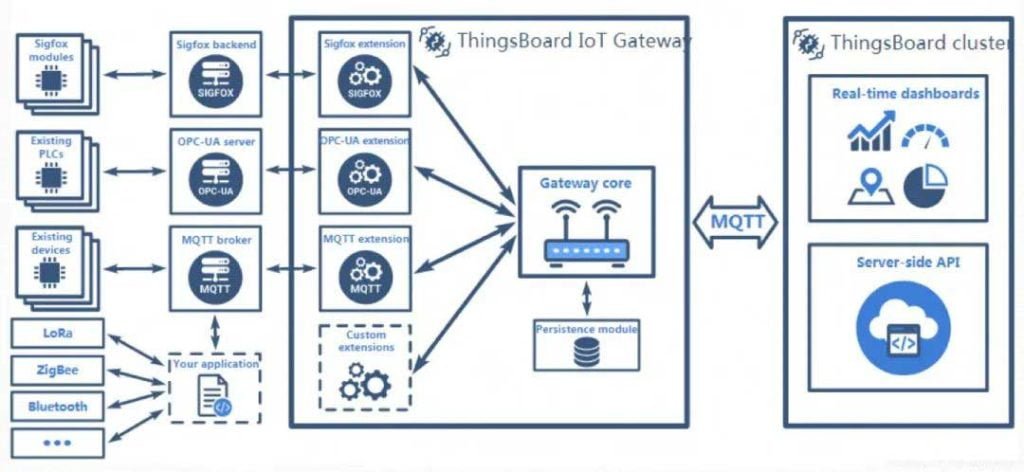
ThingsBoard’s official approved IoT gateway hardware partner is Dusun IoT. Our ThingsBoard gateways are perfectly suited to the ThingsBoard platform, allowing for simple setup and deployment. The Dusun ThingsBoard gateway evolves to meet the needs of ThingsBoard IoT Gateways in the future. It supports the BLE, Modbus, CAN, OPC-UA, LoRaWAN, and BACnet protocols for device connectivity, as well as Ethernet and LTE for cloud connectivity.
The MQTT connection, OPC-UA connector, Modbus connector, BLE connector, Request connector, CAN connector, BACnet connector, ODBC connector, RESET connector, SNMP connector, FTP connector, Socket connector, and custom connector are all simple to support on ThingsBoard. Furthermore, the gateway corresponds to industrial design standards and is ideal for a complicated industrial environment.
The waterproof gateway is essential for outside applications, notably agricultural ones. It is worth noting that all devices have satisfied most countries’ certification criteria, including FCC, CE, IC, WPC, NTC, KC, RCM, SRRC, and other certification certificates, allowing you to swiftly bring your solution to market.
Fill out the form below or send us an email. The pre-sales engineer will give you a thorough overview and assist you in determining the ThingsBoard gateway and the solution.




















